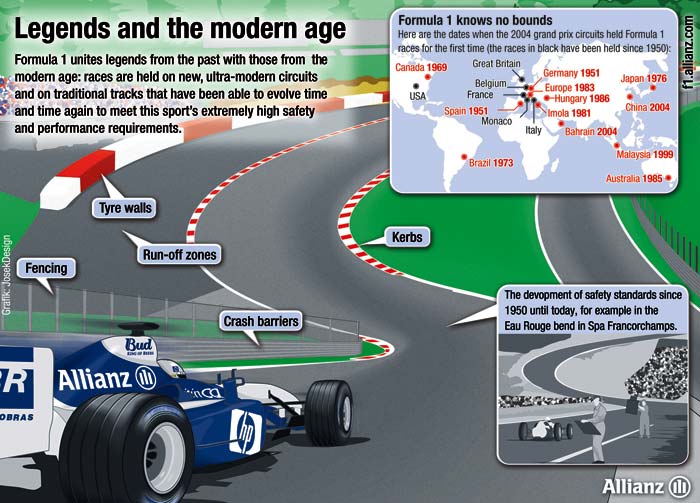Despite the rapidly expanding markets of the future, Formula 1 occasionally takes the time to look back at its past. As in the Belgian Grand Prix in Spa-Francorchamps. The historic circuit in the Ardennes is a fascinating contrast to the ultra-modern tracks and, thanks to the many improvements in terms of safety, it is now fully up to date.
When selecting its locations, motorsport’s top category – Formula 1 – opts for an appealing blend of tradition and the modern age. New tracks, such as in Bahrain and Shanghai, are hosting their first races, represent the way forward. However, despite the trend towards globalisation, the race organisers have no intention of abandoning tracks steeped in tradition such as Spa-Francorchamps or the city track in Monaco, which were already highlights back in the founding years of Formula 1.
“If it was up to us,” said Sam Michael, Technical Director at WilliamsF1, “We would prefer to still be driving on these tracks even in 15 or 20 years from now.”
By its very nature Formula 1 is a sport in the fast lane. Despite this, tradition takes pole position at many of the races. Six of the seven grand prix races in the first official Formula 1 season back in 1950 are still part of this year’s grand prix schedule, indeed five of them will be held on the same tracks: Great Britain (Silverstone), Monaco (Monte Carlo), USA (Indianapolis), Belgium (Spa-Francorchamps) and Italy (Monza).

In spite of all the changes, it is Monaco and Spa-Francorchamps in particular that have retained a great deal of their original character. The labyrinth of corners in the streets of Monte Carlo presents both drivers and teams with very special challenges, just as the rollercoaster track in the Ardennes does, which at 6.973 kilometres is the longest current grand prix track. It’s a real drivers’ track, which separates the men from the boys, particularly when the region’s typical rainfall makes its presence felt. If truth be told, it always seems to be raining somewhere on this track!
Spa-Francorchamps has achieved world fame because of Eau Rouge, the most spectacular corner in Formula 1. After the hairpin bend at La Source drivers rush down the hill at 300 km/h and drive through the left-right-left combination of corners at the bottom – if they are brave and they have set up their car perfectly, they can take the corner flat out. This is where every Formula 1 driver wins his spurs. Here
they are up against centrifugal forces of 4g, in other words four times the force of gravity. In the blink of an eye they then dart back up the 15 per cent gradient and at one point all they can see ahead of them is the sky – rather like a jet pilot climbing. No other Grand Prix track offers this kind of driving at the limit.
When recalling his debut drive in the Ardennes, record-breaking world champion Michael Schumacher said: “The moment I discovered that I could drive full throttle through Eau Rouge a deliciously warm feeling of contentment flowed through my veins.”
With 18 races on four continents, Formula 1 is a genuine world championship. A fascinating game without frontiers. It’s no surprise then, that everything is geared towards global expansion: in 1967 the first Canadian Grand Prix was held, and Brazil joined in 1973. With the Japanese Grand Prix in 1976, Asia finally took its place on the global Formula 1 map too. Formula 1 celebrated a successful debut in Australia in 1985 and likewise in 1999 in Malaysia. A special milestone in the history of Formula 1 came in 1986 with the Hungarian Grand Prix, with which Formula 1 broke down the Iron Curtain long before the politicians managed to.
Of all the traditional tracks from the fifties – the dinosaurs of Formula 1 – the only ones that have survived are those that have been able to evolve time and time again to meet this sport’s extremely high requirements in terms of safety and performance. Take the Nürburgring, for example: a state-of-the-art grand prix track was built in the shadow of the legendary North Loop, which once threaded its way along a length of 22.772 kilometres and 180 corners through the green landscape of the Eifel region – a pioneer in a new generation of racetracks.
The stringent safety regulations, as imposed by the Fédération Internationale de l’Automobile (FIA – Formula 1’s governing body), and the interests of the drivers and spectators have all been success-fully met by the new tracks in Bahrain and Shanghai. One located in the middle of a desert in the emerging oil sheikhdom, the other on 40,000 concreted pillars in a marshy area lying outside the Chinese economic metropolis. The state-of-the-art facilities were conceived by the Aachen-based architect, Hermann Tilke. His motto: a race has to be spectacular for both driver and spectator, but not to the detriment of safety. “The challenge was to design the tracks so that drivers would make mistakes and so make overtaking manoeuvres possible,” explained the lord of the new rings.”



 Guests: 619
Guests: 619 Hidden: 0
Hidden: 0 Users: 0
Users: 0